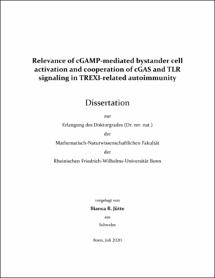Jütte, Bianca B.: Relevance of cGAMP-mediated bystander cell activation and cooperation of cGAS and TLR signaling in TREX1-related autoimmunity. - Bonn, 2020. - Dissertation, Rheinische Friedrich-Wilhelms-Universität Bonn.
Online-Ausgabe in bonndoc: https://nbn-resolving.org/urn:nbn:de:hbz:5-60156
Online-Ausgabe in bonndoc: https://nbn-resolving.org/urn:nbn:de:hbz:5-60156
@phdthesis{handle:20.500.11811/8757,
urn: https://nbn-resolving.org/urn:nbn:de:hbz:5-60156,
author = {{Bianca B. Jütte}},
title = {Relevance of cGAMP-mediated bystander cell activation and cooperation of cGAS and TLR signaling in TREX1-related autoimmunity},
school = {Rheinische Friedrich-Wilhelms-Universität Bonn},
year = 2020,
month = nov,
note = {The aberrant recognition of endogenous nucleic acids by innate immune sensors can trigger a wide range of autoimmune and autoinflammatory conditions, mediated by type I interferons. Laoss-of-function mutations in the three prime repair exonuclease 1 (TREX1) cause cytosolic accumulation of DNA, which is recognized by the cyclic dinucleotide 2’,3’-GMP-AMP (cGAMP) synthase (cGAS). cGAS catalyzes the formation of the second messenger cGAMP that in turn activates the signaling protein STING (stimulator of interferon genes). Bystander activation is a critical component of the host defense system against pathogens but has likewise been linked to the development of autoinflammatory and autoimmune diseases. During viral infections, intercellular transmission of the second messenger cGAMP represents a potent mode of bystander activation that enhances pathogen defense.
In the first part, a murine bone marrow transplantation strategy was used to demonstrate that in Trex1-/--associated autoimmunity, cGAMP shuttling from radioresistant to immune cells induces interferon regulatory factor 3 (IRF3) phosphorylation and subsequent tonic interferon signaling, as well as NF-κB (nuclear factor kappa-light-chain enhancer of activated B cell) activation. cGAMP travel protected lymphocytes and myeloid cells from apoptosis promoting their accumulation in secondary lymphoid tissue. Innate immune activation, however, did not induce B cell differentiation into autoantibody-producing plasmablasts or aberrant T cell priming in the steady state. Furthermore, cGAMP-mediated bystander activation did not lead to spontaneous organ disease, but triggered interface dermatitis after UV light exposure. These findings thus reveal that in TREX1 deficiency intercellular cGAMP transfer elicits innate immunity and, under conducive environmental conditions, triggers tissue inflammation.
url = {https://hdl.handle.net/20.500.11811/8757}
}
urn: https://nbn-resolving.org/urn:nbn:de:hbz:5-60156,
author = {{Bianca B. Jütte}},
title = {Relevance of cGAMP-mediated bystander cell activation and cooperation of cGAS and TLR signaling in TREX1-related autoimmunity},
school = {Rheinische Friedrich-Wilhelms-Universität Bonn},
year = 2020,
month = nov,
note = {The aberrant recognition of endogenous nucleic acids by innate immune sensors can trigger a wide range of autoimmune and autoinflammatory conditions, mediated by type I interferons. Laoss-of-function mutations in the three prime repair exonuclease 1 (TREX1) cause cytosolic accumulation of DNA, which is recognized by the cyclic dinucleotide 2’,3’-GMP-AMP (cGAMP) synthase (cGAS). cGAS catalyzes the formation of the second messenger cGAMP that in turn activates the signaling protein STING (stimulator of interferon genes). Bystander activation is a critical component of the host defense system against pathogens but has likewise been linked to the development of autoinflammatory and autoimmune diseases. During viral infections, intercellular transmission of the second messenger cGAMP represents a potent mode of bystander activation that enhances pathogen defense.
In the first part, a murine bone marrow transplantation strategy was used to demonstrate that in Trex1-/--associated autoimmunity, cGAMP shuttling from radioresistant to immune cells induces interferon regulatory factor 3 (IRF3) phosphorylation and subsequent tonic interferon signaling, as well as NF-κB (nuclear factor kappa-light-chain enhancer of activated B cell) activation. cGAMP travel protected lymphocytes and myeloid cells from apoptosis promoting their accumulation in secondary lymphoid tissue. Innate immune activation, however, did not induce B cell differentiation into autoantibody-producing plasmablasts or aberrant T cell priming in the steady state. Furthermore, cGAMP-mediated bystander activation did not lead to spontaneous organ disease, but triggered interface dermatitis after UV light exposure. These findings thus reveal that in TREX1 deficiency intercellular cGAMP transfer elicits innate immunity and, under conducive environmental conditions, triggers tissue inflammation.
url = {https://hdl.handle.net/20.500.11811/8757}
}






